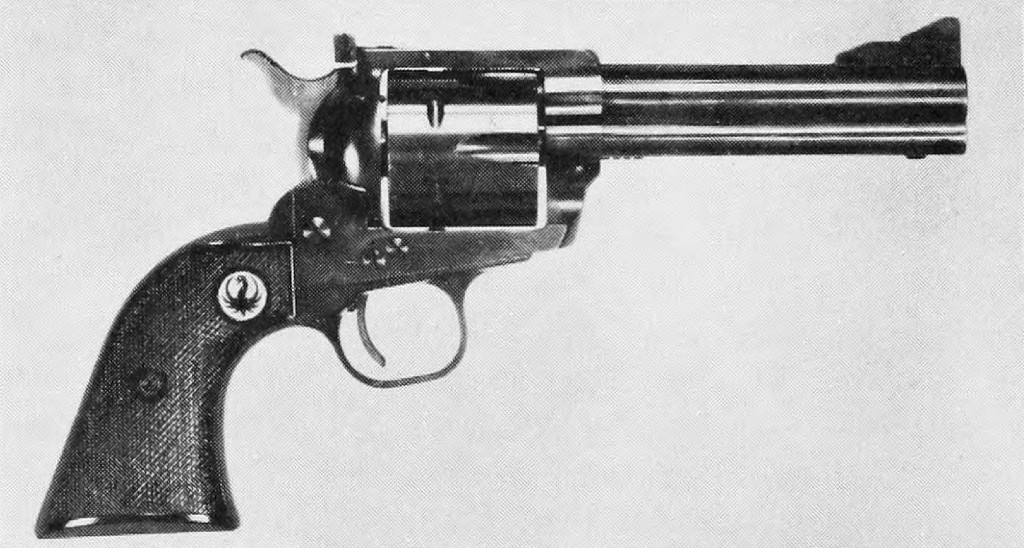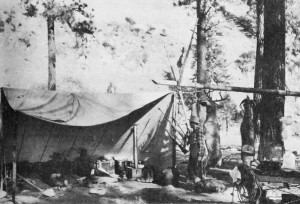If you happen to stumble onto an online forum for Ruger firearms or single action revolvers you may find that the term “3-screw Blackhawk” appears quite frequently. You may also notice that some people have a certain esteem for the 3-screw Ruger Blackhawk over other Blackhawks and will go to great lengths to acquire one.
Many people new to revolvers probably have no idea what a 3-screw Ruger Blackhawk is, and even those who know what a 3-screw Blackhawk is probably don’t understand why revolver cranks covet these relics over all others. This post will explore a little of the Ruger Blackhawk’s history and tease out why the 3-screw Blackhawk is such a desirable gun and why collectors and non-collectors alike should seek one out for themselves.
A History of the Ruger Blackhawk
The history of the Ruger Blackhawk begins with the Ruger Single Six, a single action revolver based on the Colt Single Action Army Revolver of 1873 and chambered for the .22 Long Rifle cartridge. The Single Six was a popular seller for Ruger and indicated that there was a demand for single action revolvers in post WWII America.
In 1955 Ruger introduced the Blackhawk chambered for the .357 Magnum cartridge. The Blackhawk replicated the size of the old Colt Single Action in both frame size and grip size. The Blackhawk also had adjustable sights mounted on a flattop frame like many of the custom Colts and Colt Single Action target models.
Besides replacing the Colt flat springs with coil springs for better durability and using a frame mounted firing pin, the lock work of the Ruger Blackhawk was very similar to that of the Colt. The Blackhawk hammer had four distinct clicks that could be heard while it was brought back to full cock—which was characteristic of the Colts—and to freely spin the cylinder for loading the hammer had to be placed at half-cock, another characteristic of Colts and older single action revolvers. Because the lock work was so similar to that of the Colt, the Ruger Blackhawk had three screws on the side of the frame just as the Colts did. This model 3-screw Blackhawk is commonly referred to as the “flattop” due to its flat top strap.

Around 1956 Ruger introduced a .44 Magnum version of the Blackhawk built on a larger frame to handle the increased pressures of the new cartridge. The .357 Magnum Blackhawk continued to be manufactured on the smaller Colt-sized frame, so Ruger was now producing Blackhawks in two frame sizes.
Starting in 1962 Ruger added “ears” to the top strap of the revolver around the rear sight. In Sixguns, Elmer Keith had recommended that Ruger add some protective “ears” to the rear sight to protect it from being knocked out of alignment when the rear sight was raised for long distance shooting. I am not sure whether Keith actually influenced the decision by Ruger to add the “ears”, but Sixguns was released in 1955 and a revised edition was released in 1961—both predating the “ears” on the Blackhawk—so the ears may be his handiwork.
In 1973 wholesale changes were made to the Ruger Blackhawk. The lock work was changed from that of a Colt to something completely new. Instead of setting the hammer to half-cock for loading, the loading gate now regulated the cylinder for loading and the hammer no longer had the four clicks found on previous Blackhawks and Colts. A transfer bar safety was also added which made the gun safe to carry with six rounds in the cylinder. As a result of the changes to the inner workings of the Blackhawk, there were now only two screws on the side of the frame.
In addition to the inner changes to Blackhawk, there was one notable outward change. Probably to simplify manufacturing, all Ruger Blackhawks from 1973 onward, regardless of caliber, would be built on the larger .44 Magnum sized frame. This revised revolver was renamed and released as the New Model Blackhawk, thus ending the life of the 3-screw Blackhawk.
What’s the big deal?
“So,” you may be asking, “what’s so special about the 3-screw Blackhawk? Isn’t it just an older Blackhawk? Why would a non-collector care about it?”
It’s true that the 3-screw Blackhawks are coveted by collectors for their age and status as the inaugural model the popular Ruger Blackhawk series (particularly the flattop 3-screws). But what many people overlook is that the most important change that came with the New Model Blackhawk wasn’t the new innards, it was the new body the innards were put in.
Over the course of the Blackhawk’s life it had increased in size with each revamping. In 1955 the Blackhawk was released with a grip and frame the size of the Colt Single Action Army—the gun by which all other single action revolvers are judged; a gun which had the perfect combination of size and strength for someone wanting an all-around revolver for packing into the woods or wherever he may wander; a gun which pointed so gracefully that the sights were almost unnecessary at close range.
In 1962 the “ears” were added to the Blackhawk but so was a new grip frame. The new grip was slightly larger than the previous Blackhawk grip, and consequently, larger than the Colt’s.
Some people liked the new grip while others preferred the smaller grip found on the flattop, but the change was minor and the 1962-1972 Blackhawks still handle and point well. Besides, replacing the larger grip frame on a Blackhawk with a smaller one is a relatively minor modification.
The blow came in 1973 when all Blackhawks were moved to the large frame originally built to contain the pressures of the .44 Magnum. Now all Blackhawks—whether .44 Magnum, .45 Colt, or .357 Magnum—would be built on this hulking frame.
The larger frame was obviously needed to safely chamber the .44 Magnum, and the .45 Colt certainly benefited from the larger frame size as it essentially became a .45 Colt Magnum. But the poor .357, one of the most ideal rounds for packing into the woods, receives no benefit from the larger frame at all.
The medium sized frame of the Colt Single Action Army and 3-screw Blackhawks was more than enough beef to contain .357 Magnum pressures. Heck, the .357 Magnum is safely fired in J-Frame Smith & Wesson revolvers without fear of blowing up. The .357 Magnum deserves better than being shoved into a bulky and heavy frame; it deserves a frame which matches the versatility of the cartridge itself; a frame which can be comfortably carried all day in the woods whether you are on the prowl for small game, large game, or even nothing at all.
Even the .45 Colt, a cartridge which had always been housed in the larger frame Blackhawks, is perfectly fine in the medium framed guns. Sure, the .45 Colt in the large frame Blackhawks is capable of extreme power that matches or exceeds .44 Magnum, but is it really necessary?
The .45 Colt’s legacy was built on the medium framed Colt Single Action Army, where it developed a reputation for throwing heavy pieces of lead at moderate velocities. Who could realistically need more power than a 255 grain lead bullet traveling at 900 feet per second? Perhaps more importantly, who would want to endure the recoil associated with the increased power?
Because of the size of the 3-screw Blackhawks, they became popular platforms for people to build custom revolvers on. The most popular customization was to rechamber the .357 3-screw Blackhawks to .44 Special—a cartridge which needs only the medium sized frame to reach its full potential and which Elmer Keith pushed to near .44 Magnum velocities in his custom Colt Single Actions. Skeeter Skelton had at least a couple of these conversions done and it remains a popular conversion today. If a single action aficionado is looking for a good packing or working gun, the 3-screw Blackhawk is often the revolver they turn to.
A happy ending?
Once thought to be lost forever, the medium framed Ruger revolver has made a comeback in a big way. Starting with the introduction of the New Vaquero in 2005, Ruger put the medium sized single action frame with Colt sized grips in production. These new guns still use a transfer bar safety and New Model Blackhawk lock work for the most part, but the important thing is that they returned to the svelte sized frame and grips of the old 3-screw Blackhawks and Colt Single Actions. The New Vaqueros had fixed sights, so they were no replacement for the 3-screw Blackhawks, but it was an important first step.
Shortly thereafter, to commemorate the 50th anniversary of the first Blackhawks, Ruger released a limited run of .357 Magnum New Model Blackhawks built on the medium sized New Vaquero frame with adjustable sights and a flat top strap, finally coming full circle. Unfortunately, this medium framed .357 Magnum New Model Blackhawk was only a limited run and today the .357 Magnum New Model Blackhawk has returned to being produced only in a large frame.
For a comparison of the sizes between the original Colt Single Action, the 3-screw Ruger Blackhawk, the New Model Ruger Blackhawk, and the newest medium frame Blackhawk, check out this article over at Gunblast.com. They have a table with various measurements from these guns for comparison purposes. When looking at the table, keep in mind the dimensions for the “Old Vaquero” are the same as the large frame New Model Blackhawks and the “New Vaquero” is the same size as the medium frame New Model Blackhawks.
Happily, with the help of Lipsey’s, Ruger was persuaded to introduce a .44 Special New Model Blackhawk built on the medium sized flattop frame previously used for the 50th Anniversary Blackhawk. Lipsey’s special order of these revolvers was so successful that Ruger added the revolver to their regular product line and now they can be ordered from almost any firearms retailer.
Lipsey’s also did a special run of .45 Colt New Model Blackhawks on the medium sized flattop frame, and these can be ordered from a Lipsey’s dealer. However, due to the success of the large frame .45 Colt Blackhawk, I don’t believe we will ever see this item as a regularly cataloged product from Ruger itself.
So, on the bright side, we now have the .44 Special New Model Blackhawk; a revolver which fires a spectacularly versatile cartridge in the handy medium sized frame. Elmer Keith had written about his hopes for such a gun in Sixguns in 1955 and Skeeter Skelton had dreamed of such a gun as well. Finally, fifty years after the Blackhawk was introduced, the wishes of these two men—and many other sixgun enthusiasts—came to fruition.
On the other hand, if someone wants a .357 Magnum Ruger single action revolver on the medium frame they have no viable options currently being produced. The New Vaquero is offered in .357 Magnum and is built on the medium frame, but it lacks adjustable sights. One is forced to look on the used market for a 3-screw Blackhawk or the 50th Anniversary New Model Blackhawk. The Anniversary models regularly sell for more than the 3-screw Blackhawks, plus the Anniversary models only came with the 4.625 inch barrel, so the 3-screws are still the best option.
I have hopes that someday Ruger will produce the .357 Magnum New Model Blackhawk on the medium flattop frame as a regular catalog item. After all, the medium flattop frame is already in production for the .44 Special New Model Blackhawk, the medium .357 Magnum cylinders and barrels are already in production for the New Vaquero, and the .357 Magnum has no need to be housed in a large frame revolver. To me, it looks like all the pieces are in place and I sincerely hope that this ideal .357 Magnum revolver can somehow be produced and reclaim the romance and tradition of the 3-screw Blackhawks of old.




